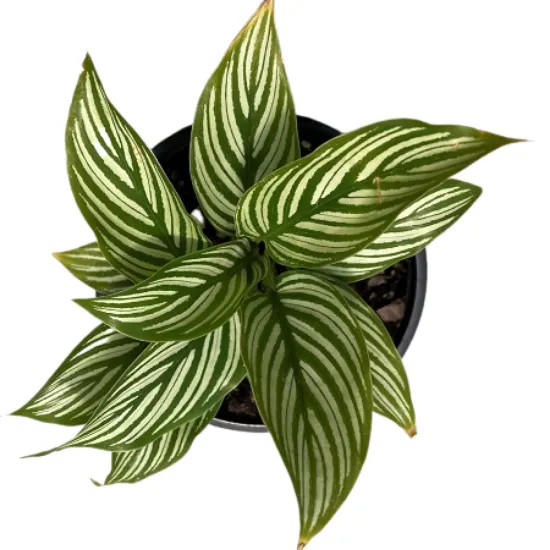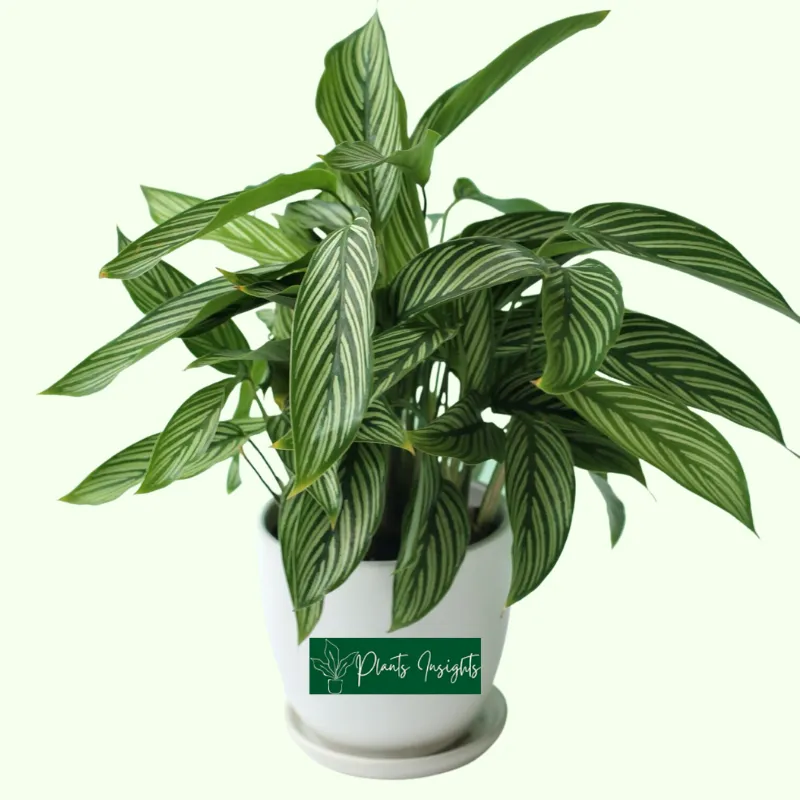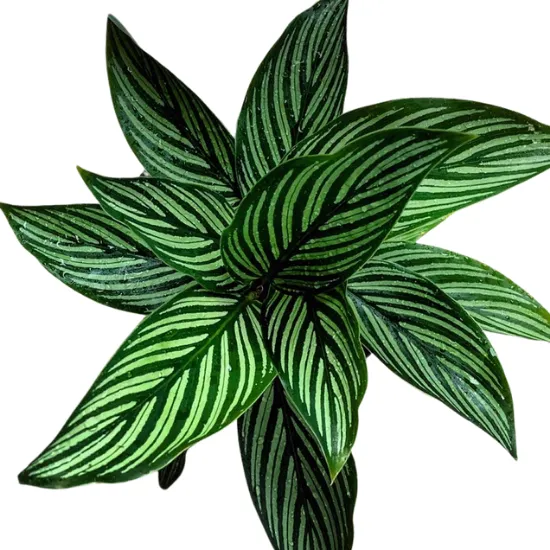How many of you are ready to add a new plant to your garden but do not know which one to add? Well, do I have a present for you! The Calathea Vittata! The Calathea Vittata belongs to the Calathea variety having leaves stretching outwards with a beautiful green glow. The plant can be a gorgeous living room decoration or tabletop décor as it is only two feet tall.
Prominent Family Members: Calathea Makoyana, Calathea Leopardina, Calathea Crocata, Calathea Rufibarba, Calathea Ornata, Calathea Orbifolia, Calathea Warscewiczii
Essential Products:
How to take care for a Calathea Vittata?
The Calathea Vittata has its particular requirements, and without them, the plant will have stunted growth or death. So, make sure you note the following things.
The soil must be made of a good soil mix that allows drainage. The plant comes from the Brazilian rainforest, and thus, it comes with the need for high humidity. The amount of water shall be in a specific order, and the fertilization time shall also be optimum. Furthermore, provide suitable temperature and brightness all around the year for stable growth.

Bringing Plant to House
Everyone, without a doubt, is excited to have a new plant in their plant collection, but there are a few things to keep an eye on.
No one is sure if there are any pests or diseases in their pets until its effect has started to change the plant’s physical appearance. So, keep the new plant away from your other plants for a couple of weeks to avoid spreading the disease to other houseplants. Please keep inspecting the plant for any prevalent disease during the isolation period. Once you are satisfied with the plant’s health, place the plant at the permanent location.

Light Requirement for Calathea Vittata
Calathea Vittata’s light requirements are pretty specific. Keeping the plant where enough indirect light is available is necessary to maintain its beauty and vigor.
Native to Southern America, where the climate is quite humid and hot. The tropical rain forest has 200 to 300 cm annual rainfall. Hence excess rainwater makes the jungle dance with big trees, and the canopy of those trees doesn’t let pass the direct sunlight to the ground. Shade lover plants are dominantly growing under that canopy’s shades; Calathea Vittata is one of them!
If you want to make the Viattata’s permanent display outdoors, you must pot the plant under the shade of a tree or where medium indirect sunlight can reach the plant.
While indoors, the best place is two feet away from the window, which allows the rising sunlight to pass through.
If your Vittata Plant starts losing the bright color of its leaves, the reason is exposure to high-intensity direct sunlight. To recover the plant, move it to a medium diffused light area. If there is no other suitable palace in the home, provide an artificial shade. You can make an artificial shade with various materials available in garden centers with different strengths, colors, and weights. They also come as UV-stabilized polyethylene shelters, aluminum shade fabric, and net material.
While inspecting the plants, it’s time to solve their light issues if you notice Calathea Vittata plant becoming leggy, not growing well, or leaves start fading their color.

Temperature and Humidity
As mentioned above in the light requirements chapter, the average rainfall of the tropical rain forest is 200 to 300 centimeters, which is relatively high. Plants from this region want a copy of that atmosphere; therefore, tropical plants like Calathea Vittata and Pinsktripe Calathea demand high humidity.
Calathea requires more than 50% humidity but the Vittata plant thrives happily in 60 to 70% humid surroundings. Invest your money to buy a hygrometer that will help you monitor the required humidity level indoors.
How to increase humidity indoors?
Suppose you catch your Vittate Calathea with low humidity signs like crispy brown leaf and edges of brown leaf tips; few measures are required to make it lively again.
The Vittata plant care includes consistent warm temperatures too. The perfect temperature is 65 to 85°F, almost like room temperature. They can tolerate above 75°F degrees because of their native land environment, which is hot.
The plant does not respond well to variations in temperatures; therefore, avoid cold or hot drafts as they can harm the Vittata plant.
Calathea Vittata can withstand temperatures below 60 °F for a few days, but the plant will wilt if kept under cold temperatures for long. Therefore, make sure to move the Calathea Vittata plant indoors once the outdoor temperatures become below 60 °F during autumn.

Do Calathea Vittata Bloom?
Calathea Vittata is well-known because of its beautiful foliage pattern. It is kept indoors for the gorgeous white and green contrasting leaves, not flowers. In native Brazil, the plant blooms in the natural environment, but it’s scarce to see the Vittata blooming indoors. Nonetheless, the Vittata flower is light yellow and not that attractive and prominent compared to leaves.

Watering Requirements Vittata Calathea
The Vittata plant care requires a strict watering routine. As they are habitual to living in the moist soil of tropical rainforests, they demand wet soil all the time. However, avoid overwatering as it makes pot soil soggy or waterlogged which causes the roots to be susceptible to fungal diseases and roots rot. Leaves changing their color to yellow is the early sign of extra wet soil.
From early summer to spring Calathea Vittata plant grows moderately and requires water two times a week. In addition, before watering, check the soil moisture. To check the soil’s moisture level, grab the soil in your hand and close your fingers to squeeze it. If the soil sticks together, it means it’s moist, but if it crumbles or is loose in your hand, it requires more water.
Furthermore, the easiest way to check your soil’s moisture is Moisture Meter, which comes with a scale to inform either soil is dry, moist, or soggy.
In winter, watering requirements reduces, and once a week will be enough. Moreover, after watering, be sure that excess water has drained out from the pot’s drainage hole. Poor drainage will lead to a waterlogging situation.
Quality of water matters if you want healthy growth of Calathea Vittata. Tap water contains fluoride and chlorine in different amounts, and Calatheas are sensitive to these chemicals. Accumulation of these chemicals in a plant will lead to plant leaves curling or burning leaf tips.
If you live in an area with heavy rainfall, you can accumulate rainwater and utilize it for watering. On the contrary, if it’s not possible to get rainwater, use distilled or filtered water for Calathea Vittata’s watering needs.

Soil mixture for Calathea Vittata
Soil plays a most crucial part in Calathea’s growth. Select the soil having the following essential qualities.
A balanced mixture of different soil is necessary since the plant remains happy in moist soil.
Try these two combinations, which work well for my Calathea Vittata.
African violet mix is ready-made soil available online or from your local garden store. Just buy and use it; no mixing of other soil constituents is required.
If you couldn’t find ready-made soil, mix two parts potting mix, with 1 part each of perlite, peat moss, and orchid bark.

Vittata plant Grooming and Pruning
Pruning is an exercise to remove selected plants parts to give them a proper shape or cut away the infected or damaged portions. However, pruning of Vittata is less important than the other factors like light, humidity, and temperature.
Usually, pruning is more beneficial when Calathea Vittata is invaded by disease or pest. Plants utilize much energy to overcome these pest problems and fight against diseases; removing the sick leaves saves energy and utilizing it to make the plant lively and green. Furthermore, pruning helps control disease spread; therefore, please cut off the infected leaves, roots, or stems with a sharp serialized knife or scissor.
Please make a routine of cleaning Calathea Vittata leaves with a clean, soft, and damp cloth. Wiping out the leaves will make them free from dust and pests. Furthermore, the clean surface of leaves eventually helps them breathe well and adds to the plant’s vigor. Please also ensure to wipe the extra water away from leaves each time you mist your plant to keep it bacteria-free.

Fertilizing Vittata plant
Fertilizer boosts the growth of the Vittata plant and enhances its appearance by a healthy and vibrant green look. Fertilization is required in the growing season from spring to summer once a month.
Apply fertilizer in a recommended amount, which is written on the packet. Make a dilute solution and apply that solution after watering. Don’t over-fertilize the plant. The excess salts will accumulate in the soil and negatively affect plant health. Signs of over-fertilization are wilting of plants and yellowing of the leaves.
Suppose you see that salt’s crust on the soil surface, dig the soil with a sharp tool, and wash the soil with running water. Flushing of soil will let excessive salts flow away from the drainage hole along with water.

Repotting Calathea Vittata Plant
Roots play a vital role in plant growth and absorb water and nutrients; therefore, repotting is very necessary because as the roots grow, they tend to tangle with each other and start getting damaged if pot space is a constraint.
Repotting of Calathea Vittata is not a frequent activity like pruning and will be required after one or two years, depending upon plant growth and pot size. Repotting is a process in which you take your plant out of the old pot and replant it in a new bigger pot.
Early spring before the growing season is a suitable time to repot your outgrown Calathea plant.
Repotting is relatively easy to do; first of all, take a 2-inch bigger pot than the previous pot. Next, put a well-drained pot mixing moist soil in it. Lose the soil from the pot and gently pull out the plant from the pot and replant it in a new pot. Keep it in the same depth in the soil as it was before. Finally, please put it in the same place where it was placed before.

Propagation of Calathea Vittata
Propagation means increasing of same plant’s numbers through seeds, roots, shoots, or growing buds. The most successful method for Calathea Vittata propagation is through the division of roots. Some Calathes propagate through stems and leaf cuttings, but unfortunately, Vittata doesn’t propagate through the branch or lead cutting.
For propagation, the Vittata plant follows these steps.

Is Calathea Vittata safe for pets?
Calathea Vittata is not a poisonous plant and is completely safe for humans and pets. Therefore, there is no need to worry if your pet ingests the plant leaves by accident. Similarly, there is no concern for kids if they play around the plant.

Pests Diseases and common Queries
Pests
Mostly Calatheas have good resistance against diseases and pests. The most common pest is spider mites as the bigger leaves are attractive for spider mites to make colonies and start living on them. These colonies of spider mites feed on plant nutrients by sucking the leaf sap.
If your plant is the host of these spider mites, wipe clean the leaves manually to remove the pests. You can also apply neem oil as it has proven as an effective natural pesticide repellent. If the infestation still exists, you can clean the leaves with a 10% solution of rubbing alcohol or insecticides soap.
Furthermore, aphids and mealybugs also attack Vittata leaves, and they shall be treated similarly to spider mites.
Diseases
Calathea is affected mainly by a fungal disease of roots called root rot. It is usually caused by overwatering and roots exposure to water for an extended period. The disease badly affects plants’ growth and can cause the death of the plant. A good watering routine and draining soil will keep the Vittata plant safe from fungal disease.
Other moisture-related diseases are the Alternaria and Helminthosporium leaf spots. After misting, water drops on leaves invite fungus to attack the leaves. To prevent leaf spots, wipe out the water from the leaves’ surface after misting. You may use fungicides to get rid of these leaf spots or prune the unhealthy leaves from the plant.
Why my Calathea Vittata Leaves are yellowing?
The yellowing of leaves starts when the soil remains soggy or waterlogged for a more extended period. If you observe excessive yellowing of the leaves, check the plant soil. Changing the soil and replanting the plant in dry soil is preferable if the soil is overly wet. Resume rewatering the plant after observing the soil moisture level.
Another reason for leaf yellowing is insufficient light available to Calathea Vittata for an extended duration. Change the plant position and give it medium-indirect sunlight exposure to overcome the problem.
Why does my Vittata has brown and crispy tips ?
Too much dry soil or intense light is the reason for the browning of the leaves and crispy edges. To mitigate these problems, water the plant correctly, provide good humidity, and prune the dead leaves to give a new look to your plant.

Brow and Crispy tips of Calatha Vittata Leaves
Why is my Calathea Vittata drooping and curling?
Calathea Vittata is very sensitive to its surrounding factors. Too much dry surrounding and dry soil will cause your plant leaves to droop. In such a case, instantly provide the plant with optimum humidity and moist the soil by watering.
Leaves of Calathea Vittata will curl if they are exposed to high temperatures. Leaves curling is a defense mechanism nature has implanted in these plants. The curling of leaves reduces the exposed surface area to heat and decreases the evaporation rate of moisture through leaves. Remove the heat source or place the plant in a more relaxed place to avoid the problem.

Calatha Vittata Leaves Curling
How often should I water my Calathea Vittata plant in summer?
In summer, days and nights are hot, and plants are also growing. They require moist soil all the time. Before watering, check the soil with a moister meter or put your finger in the soil. If it feels like dry soil, water it. During summer, mostly two-times a week watering schedule shall work; however, observe the soil condition before finalizing the watering frequency.
Does Calathea Vittata clean the air?
Calathea Vittata is a beautiful mantlepiece, and it also purifies the air around the plant. If you keep your windows and doors closed, you will have cleansed air all over the house! The amount of purity in the air depends on how many Vittata’s are in your place.
Where should I put my Calathea Vittata?
Calathea Vittata is a beautiful small plant that reaches a maximum height below two feet. Place it in a corner with medium light and let it thrive peacefully, or else you can place them two feet apart from east-facing windows.
Which pots are the best for Calathea Vittata?
When it comes to materials, all types can work, plastic, terracotta, but the size should be of the perfect size. In terracotta pots, moisture evaporates quickly; therefore, adjust your watering frequency accordingly. Do not replant them too often, or it will slow down their growth and cause the plant to stop growing. Please make sure the pot has a sound drainage system.
Is Calathea Vittata a prayer plant?
Calathea Vittata is a member of the Marantaceae family, to which prayer-plants also belong, and Calatheas are also mistakenly called the Prayer Plant. However, Calatheas are not truly the prayer-plants even though they fold the leaves when the sun goes down, trying to conserve energy during the night.
But, the movement is not like praying hands for which prayer-plants like Red Vein Prayer Plants are famous. Therefore, it is a misconception that Calatheas are a prayer plant.









